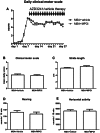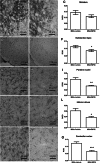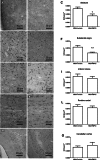Failure of Neuroprotection Despite Microglial Suppression by Delayed-Start Myeloperoxidase Inhibition in a Model of Advanced Multiple System Atrophy: Clinical Implications
- PMID: 26194617
- PMCID: PMC4556742
- DOI: 10.1007/s12640-015-9547-7
Failure of Neuroprotection Despite Microglial Suppression by Delayed-Start Myeloperoxidase Inhibition in a Model of Advanced Multiple System Atrophy: Clinical Implications
Abstract
Multiple system atrophy (MSA) is a rapidly progressive neurodegenerative disease. Post-mortem hallmarks of MSA neuropathology include oligodendroglial α-synuclein (αSYN) inclusions, striatonigral degeneration, olivopontocerebellar atrophy, and increased microglial activation that accompanies the wide spread neurodegeneration. Recently, we demonstrated upregulation of myeloperoxidase (MPO) in activated microglia and provided evidence for the role of microglial MPO in the mediation of MSA-like neurodegeneration (Stefanova et al. Neurotox Res 21:393-404, 2015). The aim of the current study was to assess the therapeutic potency of MPO inhibition (MPOi) in a model of advanced MSA. We replicated the advanced pathology of MSA by intoxicating transgenic PLP-α-synuclein transgenic mice with 3-nitropropionic acid (3NP). After onset of the full-blown pathology, MSA mice received either MPOi or vehicle over 3 weeks. Motor phenotype and neuropathology were analyzed to assess the therapeutic efficacy of MPOi compared to vehicle treatment in MSA mice. MPOi therapy initiated after the onset of severe MSA-like neuropathology in mice failed to attenuate motor impairments and neuronal loss within the striatum, substantia nigra pars compacta, inferior olives, pontine nuclei, and cerebellar cortex. However, we observed a significant reduction of microglial activation in degenerating brain areas. Further, nitrated αSYN accumulation was reduced in the striatonigral region. In summary, delayed-start MPOi treatment reduced microglial activation and levels of nitrated αSYN in a mouse model of advanced MSA. These effects failed to impact on motor impairments and neuronal loss in contrast to previously reported disease modifying efficacy of early-start therapy with MPOi in MSA.
Figures




Similar articles
-
Myeloperoxidase inhibition ameliorates multiple system atrophy-like degeneration in a transgenic mouse model.Neurotox Res. 2012 May;21(4):393-404. doi: 10.1007/s12640-011-9294-3. Epub 2011 Dec 8. Neurotox Res. 2012. PMID: 22161470
-
Progressive striatonigral degeneration in a transgenic mouse model of multiple system atrophy: translational implications for interventional therapies.Acta Neuropathol Commun. 2018 Jan 3;6(1):2. doi: 10.1186/s40478-017-0504-y. Acta Neuropathol Commun. 2018. PMID: 29298733 Free PMC article.
-
Rasagiline is neuroprotective in a transgenic model of multiple system atrophy.Exp Neurol. 2008 Apr;210(2):421-7. doi: 10.1016/j.expneurol.2007.11.022. Epub 2007 Dec 4. Exp Neurol. 2008. PMID: 18222424
-
Models of multiple system atrophy.Curr Top Behav Neurosci. 2015;22:369-93. doi: 10.1007/7854_2013_269. Curr Top Behav Neurosci. 2015. PMID: 24338664 Free PMC article. Review.
-
Multiple system atrophy: alpha-synuclein and neuronal degeneration.Neuropathology. 2007 Oct;27(5):484-93. doi: 10.1111/j.1440-1789.2007.00841.x. Neuropathology. 2007. PMID: 18018485 Review.
Cited by
-
Myeloperoxidase: Regulation of Neutrophil Function and Target for Therapy.Antioxidants (Basel). 2022 Nov 21;11(11):2302. doi: 10.3390/antiox11112302. Antioxidants (Basel). 2022. PMID: 36421487 Free PMC article. Review.
-
Immunohistochemical and Molecular Investigations Show Alteration in the Inflammatory Profile of Multiple System Atrophy Brain.J Neuropathol Exp Neurol. 2018 Jul 1;77(7):598-607. doi: 10.1093/jnen/nly035. J Neuropathol Exp Neurol. 2018. PMID: 29850876 Free PMC article.
-
The Add-On Effect of Lactobacillus plantarum PS128 in Patients With Parkinson's Disease: A Pilot Study.Front Nutr. 2021 Jun 30;8:650053. doi: 10.3389/fnut.2021.650053. eCollection 2021. Front Nutr. 2021. PMID: 34277679 Free PMC article.
-
DNA damage and neurodegenerative phenotypes in aged Ciz1 null mice.Neurobiol Aging. 2018 Feb;62:180-190. doi: 10.1016/j.neurobiolaging.2017.10.014. Neurobiol Aging. 2018. PMID: 29154038 Free PMC article.
-
Human myeloperoxidase (hMPO) is expressed in neurons in the substantia nigra in Parkinson's disease and in the hMPO-α-synuclein-A53T mouse model, correlating with increased nitration and aggregation of α-synuclein and exacerbation of motor impairment.Free Radic Biol Med. 2019 Sep;141:115-140. doi: 10.1016/j.freeradbiomed.2019.05.033. Epub 2019 Jun 6. Free Radic Biol Med. 2019. PMID: 31175983 Free PMC article.
References
Publication types
MeSH terms
Substances
Grants and funding
LinkOut - more resources
Full Text Sources
Other Literature Sources
Research Materials
Miscellaneous

